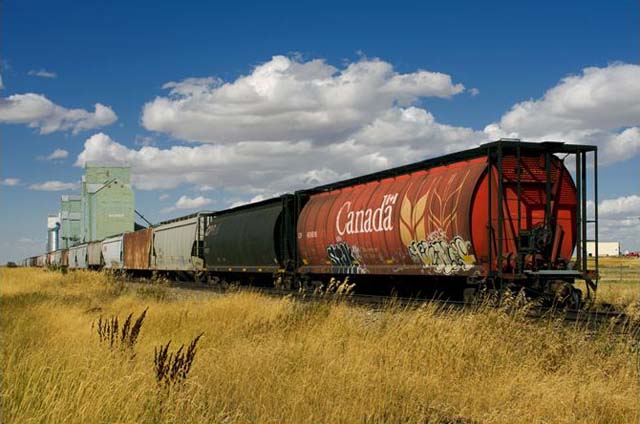

Railway Revenue Cap Value
The Canadian Prairies - The Maximum Revenue Entitlement (MRE) is the next farm policy battleground, but it won't be farmers battling against
other farmers.
There's rare unanimity among farm organizations that the MRE, more commonly known as the railway revenue cap, has value.
Groups ranging from the Western Canadian Wheat Growers to the National Farmers Union are in basic agreement.
So are general farm organization such as Keystone Agricultural Producers and the Agricultural Producers Association of Saskatchewan.
The major elevator companies through the Western Grain Elevator Association also support keeping the revenue cap.
All these organizations and many others conveyed their views to the Canada Transportation Act Review Panel led by David Emerson.
Therefore, it was somewhat of a surprise to see the panel recommend modernization and eventual elimination of the cap.
The panel obviously gave more weight to the two major railways, which would love to see an end to any regulation of freight rates.
Shippers of other commodities don't have the benefit of rate regulation, so they may also be lobbying for change.
Everyone needs to be clear that the MRE is not a rate cap.
It is adjusted annually to account for inflation and the volume of grain moved.
Are the railways losing money on grain?
Most analysts believe the railways are handsomely compensated for grain despite the revenue cap, considering that they have been able to keep efficiency
gains.
With the consolidation of the grain handling system and the move to ever-larger unit trains, railway costs should have declined in the many years since the
revenue cap was implemented.
Only a costing review would tell the tale for sure, and that's a long, onerous, process with results still open to interpretation.
It's pretty easy to predict what will happen to grain freight revenue and therefore rates if the MRE is removed.
The railways are consistently at or above the amount they are allowed to earn from grain.
Considerable railway resources are no doubt devoted to understanding the complex formula and extracting all the money allowed.
Would service to the grain industry improve without the revenue cap?
By economic theory, that should happen.
In practice, most observers believe rates would rise, but service wouldn't change.
The sectors that don't have freight revenue regulation also complain about bad service.
It's also interesting to note that grain movement to the U.S. and Mexico is not part of the MRE calculation, and yet that movement has some of the worst
service and predictability.
The Emerson report does make some valid points on modernizing the revenue cap.
For instance, each railway should receive credit for its investments rather than pooling investments between the two.
As well, it's reasonable for other commodity sectors to wonder why grain has freight rate protection and they do not.
One difference to note is the structure of the industries.
Except for producer cars, farmers are not the actual shippers of grain.
In coal, oil, and potash, the producer of the commodity is usually the shipper, which gives them more ability to negotiate and adjust to changing freight and
market realities.
In the grain business, farmers produce and then hand the product to someone else to reach salt water.
Throughout prairie history, there have been various levels of protection on grain freight rates.
The revenue cap has its flaws, and it could be improved for all involved.
However, farmers should fight tooth and nail to retain some level of freight certainty.
You can bet the new federal government will hear a lot on this issue from producers who are uncharacteristically united.
Time will tell whether they can out-lobby the railways.
Kevin Hursh.
OKthePK Joint Bar Editor: What does the revenue cap have to do with service to the grain industry? Does it keep farmer's costs down? Ever since the early 1900's when the "Crow Rate" was accepted by Canadian Pacific to enable financial construction of the Crowsnest railway through southern Alberta and British Columbia, and later when the rate was extended in scope, Canadian farmers have had a sense of "entitlement" over railway freight rates. Why are they entitled to rate protection when others are not? The current fleet of government Trudeau (the first one) hoppers are on their last legs and the crunch is coming, bad winter or not. With a revenue cap where's the incentive for railways to invest in new hopper cars?


